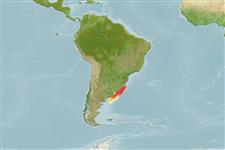Common names from other countries
>
Eupercaria/misc (Various families in series Eupercaria) >
Sciaenidae (Drums or croakers)
Etymology: Umbrina: Latin, umbra, -ae = shadow, in the sense of phantom; due to its quick movements (Ref. 45335).
Issue
Berg, C.
Environment: milieu / climate zone / depth range / distribution range
Ecologia
marinhas; estuarina demersal; oceanódromo (Ref. 51243); intervalo de profundidade ? - 200 m (Ref. 47377), usually 10 - 100 m (Ref. 27363). Subtropical; 31°S - 42°S, 62°W - 49°W (Ref. 54933)
Southwest Atlantic: Cabo de São Tomé, Rio de Janeiro, Brazil to Bonaerensis, Argentina.
Length at first maturity / Tamanho / Peso / Idade
Maturity: Lm 15.9, range 17 - ? cm
Max length : 53.3 cm TL macho/indeterminado; (Ref. 39376); common length : 37.0 cm TL macho/indeterminado; (Ref. 7025); Idade máx. registada: 26 anos (Ref. 7025)
Espinhos dorsais (total) : 11; Raios dorsais moles (total) : 21 - 25; Espinhos anais: 2; Raios anais moles: 7 - 8. Upper part of body with many dark longitudinal stripes; no well defined dark spots at bases of pectoral fins (Ref. 27363).
Especially abundant at about 100 m depth (Ref. 27363). Found over sand and mud bottoms (Ref. 47377).
Life cycle and mating behavior
Maturities | Reprodução | Spawnings | Egg(s) | Fecundities | Larvas
Haimovici, M., 1988. Cohort analysis on the Argentine croaker (Umbrina canosai) exploited in South Brazil, Uruguay and Argentina. Publ. Com. Tec. Mixta Frente Marit. Argent. Urug. 4:33-40. (Ref. 7415)
Categoria na Lista Vermelha da IUCN (Ref. 130435)
CITES (Ref. 128078)
Not Evaluated
Ameaça para o homem
Harmless
Utilização humana
Pescarias: altamente comercial
Ferramentas
Relatórios especiais
Descarregue XML
Fontes da internet
Estimates based on models
Preferred temperature (Ref.
115969): 8 - 19.8, mean 14.8 (based on 242 cells).
Phylogenetic diversity index (Ref.
82804): PD
50 = 0.5000 [Uniqueness, from 0.5 = low to 2.0 = high].
Bayesian length-weight: a=0.00891 (0.00728 - 0.01090), b=3.08 (3.06 - 3.10), in cm Total Length, based on LWR estimates for this species (Ref.
93245).
Nível Trófico (Ref.
69278): 3.9 ±0.57 se; based on food items.
Resiliência (Ref.
120179): Médio, tempo mínimo de duplicação da população 1,4 - 4,4 anos (K=0.26-0.27).
Fishing Vulnerability (Ref.
59153): Low to moderate vulnerability (32 of 100).
Climate Vulnerability (Ref.
125649): Moderate to high vulnerability (49 of 100).
